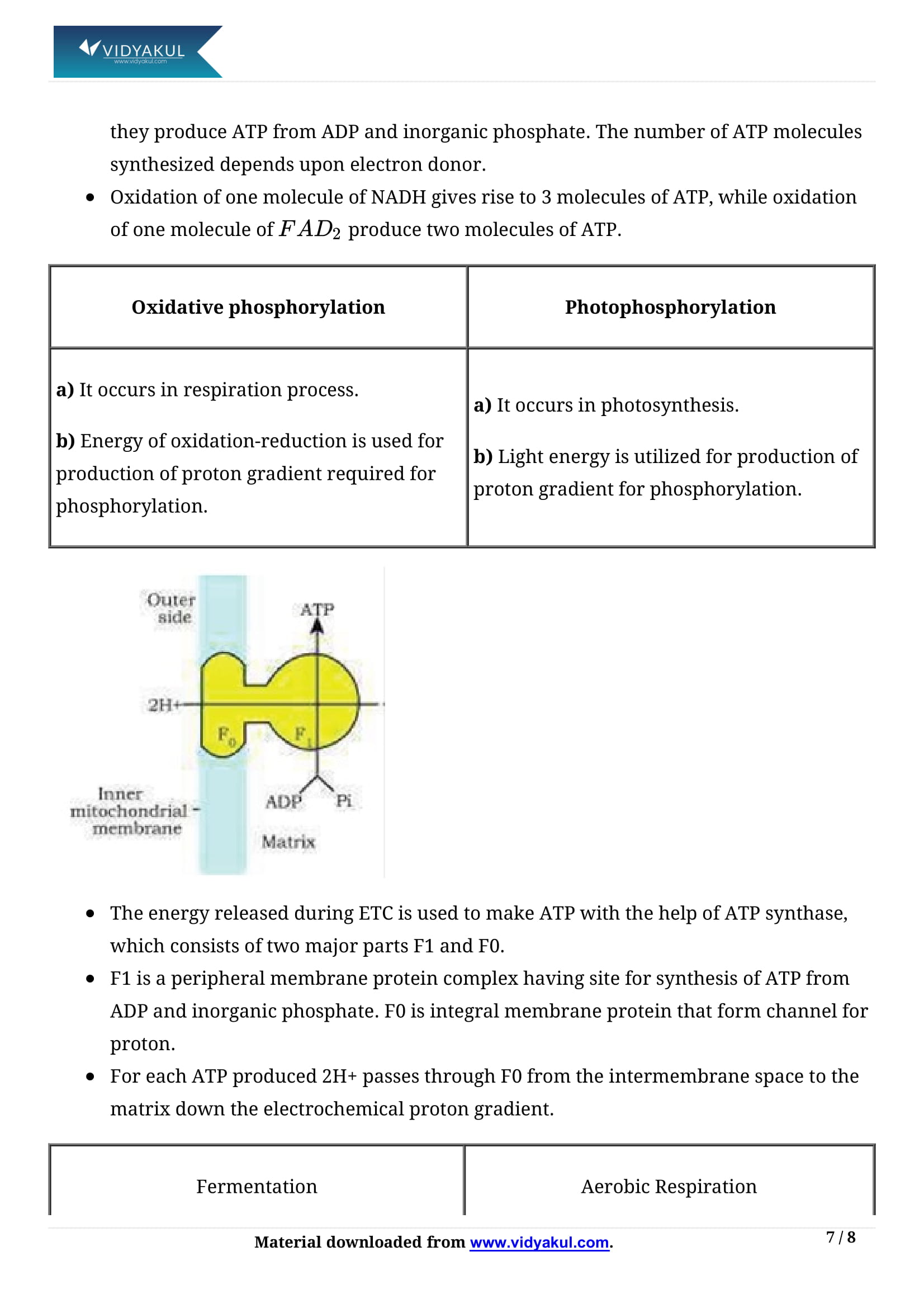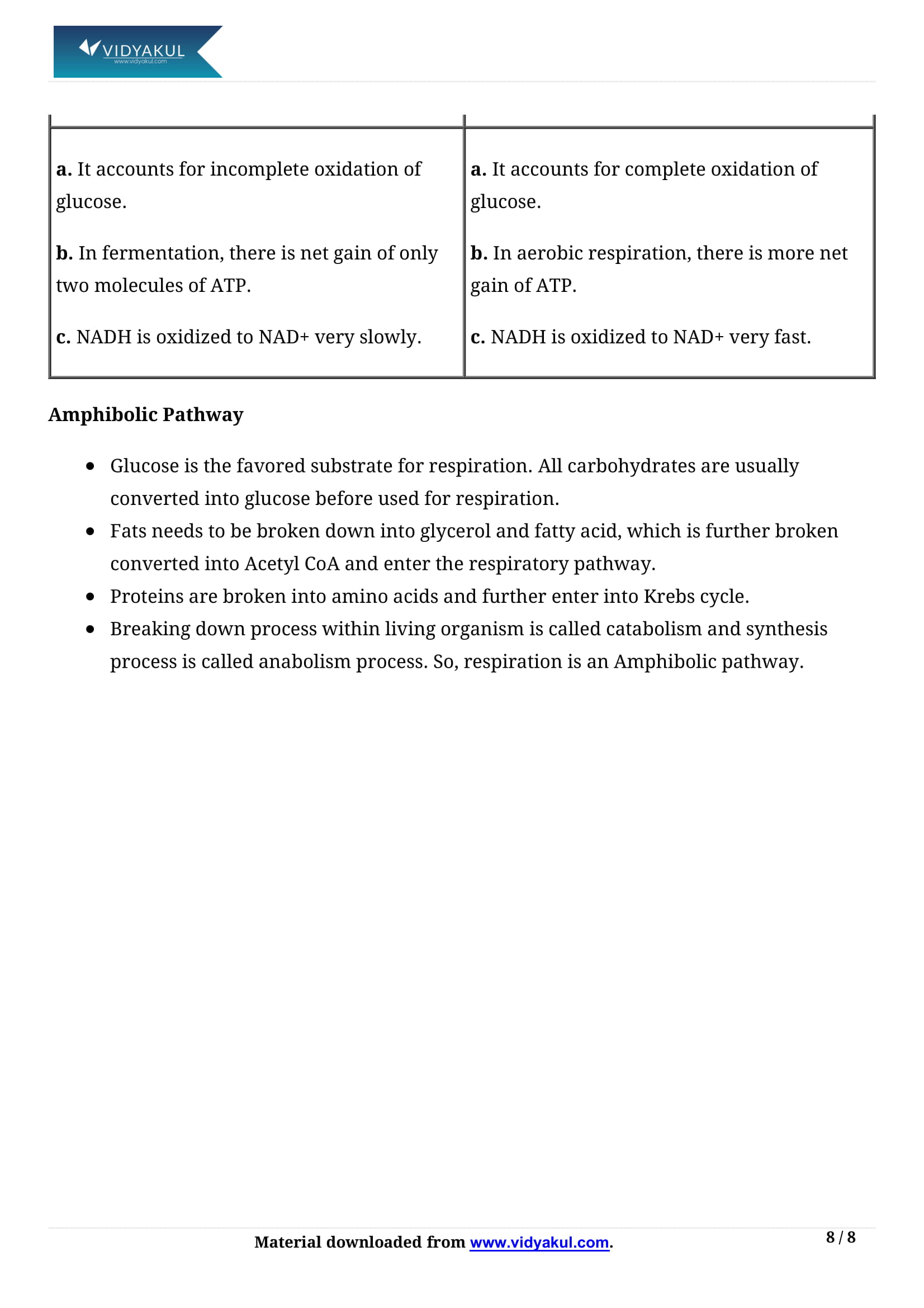Respiration in Plants Class 11 Notes

Chapter 14 Respiration in Plants
Chapter 14 of Grade 11 Biology helps students understand basic concepts related to plant respiration. Topics covered in this chapter include respiratory balance, amphibian pathways, fermentation, aerobic respiration, glycolysis, introduction to plant respiration, and the respiratory index.
This chapter contains 12 questions to help students test their understanding of concepts. Vidyakul's NCERT notes explains each question in detail and helps students better understand the concept. Continue reading this article to learn more about the NCERT Biology Class 11 Chapter 20 notes.
CBSE CLASS 11 BIOLOGY CH-14
Points to Remember
6H12O6+6O2→6CO2+6H2O+EnergyC6H12O6+6O2→6CO2+6H2O+Energy
Living organism require energy for all activities like absorption, movement, reproduction or even breathing. Energy required is obtained from oxidation of food during respiration.
Cellular respiration is the mechanism of breaking down of food materials within the cell to release energy for synthesis of ATP.
Breaking down of complex molecules takes place to produce energy in cytoplasm and in the mitochondria.
Breaking down of C-C bond of complex compounds through oxidation within the cells leading to release of energy is called respiration. The compounds that get oxidized are called respiratory substrates.
Energy released during oxidation is not used directly but utilized in synthesis of ATP, which is broken down when energy is required. Therefore, ATP is called energy currency of cells.
The process of respiration requires oxygen. In plants oxygen is taken in by stomata, lenticels and root hairs.
Plants can get along without respiratory organs because:
Each plant part takes care of its own gas-exchange needs.
Plants do not present great demands for gas exchange.
Distance that gases must diffuse in large plant is not great.
During photosynthesis O2 is released in leaves and diffuse to other part of leaves.
During process of respiration oxygen is utilized and carbon dioxide and water is released along with energy molecules in form of ATP.
Respiratory Quotient is the ratio of the volume of carbon dioxide produced to the volume of oxygen consumed in respiration over a period of time. RQ is equal to one for carbohydrate and less than one for protein and peptone
Topics and Sub-topics
Chapter 14 of Grade 11 Biology helps students understand basic concepts related to plant respiration. Topics covered in this chapter include respiratory balance, amphibian pathways, fermentation, aerobic respiration, glycolysis, introduction to plant respiration, and the respiratory index.
This chapter contains 12 questions to help students test their understanding of concepts. Vidyakul's NCERT notes explains each question in detail and helps students better understand the concept.
Continue reading this article to learn more about the NCERT Biology Class 11 Chapter 20 notes.
Frequently Asked Questions
Explain Glycolysis. State where it occurs and its end products. In both aerobic and anaerobic respiration, determine the fate of these products.
It takes place in the cytoplasm of the cell and is seen in all living entities. In this, glucose goes through partial oxidation for the formation of pyruvic acid(2 molecules). It is obtained from the sucrose in plants which is the resulting product of photosynthesis. Invertase converts sucrose into fructose and glucose which enter into the glycolytic pathway. These are phosphorylated to produce glucose-6-phosphate which isomerizes to generate fructose-6-phosphate. A sequence of 10 reactions regulated by different enzymes occurs in glycolysis to yield pyruvate from glucose. The chief product of glycolysis is pyruvic acid. The cellular need decides pyruvate’s metabolic fate. The three modes in which various cells manage pyruvic acid produced by glycolysis are – lactic acid fermentation, aerobic respiration, and alcoholic fermentation. Under anaerobic conditions in unicellular eukaryotes and prokaryotes, fermentation takes place. Kreb’s cycle or aerobic respiration is observed in entities for the complete oxidation of glucose into carbon dioxide and water which requires the supply of oxygen.
Explain the significance of Oxygen in aerobic respiration in the context of ETS.
The aerobic process of respiration occurs in the existence of oxygen and the function of oxygen is limited to the final phase of the process. Presence of oxygen is important as it drives the process by eliminating hydrogen from the system. Oxygen serves as the last hydrogen acceptor. In respiration, the energy of oxidation-reduction is used as opposed to the process of photophosphorylation where light energy is used for the generation of proton gradient that is required for phosphorylation. Hence it is called oxidative phosphorylation. Without oxygen, electrons cannot pass through the co-enzymes and in turn proton pump will not take place hence ATP will not be produced.
What are some of the assumptions we make in the respiratory balance sheet? Are these valid enough to be applied to living systems? State comparisons between aerobic respiration and fermentation corresponding to respiration.
Following are the assumptions:
The sequential pathway that follows – TCA cycle, glycolysis, and ETS in the cytoplasm, mitochondrial matrix, and inner mitochondrial membrane respectively.
NADH, synthesized in glycolysis enters into ETC for phosphorylation
In the pathway, not one of the intermediates are utilized for the synthesis of compounds
Glucose forms the respiratory substrate
These assumptions do not apply to the living system as:
The pathways occur simultaneously and not one after the other
Utilization of ATP only when required
Rate of enzyme actions is regulated by several means
Listed below is the comparison between fermentation and aerobic respiration
Practice Questions
1. Where does ETC found in eukaryotic cell?
2. Name the first product formed in Kerb’s cycle.
3. What is the significance of stepwise release of energy in respiration?
4. Explain fermentation.
5. Define RQ. What is its value for fats?
Living organism require energy for all activities like absorption, movement, reproduction or even breathing. Energy required is obtained from oxidation of food during respiration.
Cellular respiration is the mechanism of breaking down of food materials within the cell to release energy for synthesis of ATP.
Breaking down of complex molecules takes place to produce energy in cytoplasm and in the mitochondria.
Breaking down of C-C bond of complex compounds through oxidation within the cells leading to release of energy is called respiration. The compounds that get oxidized are called respiratory substrates.
Energy released during oxidation is not used directly but utilized in synthesis of ATP, which is broken down when energy is required. Therefore, ATP is called energy currency of cells.
The process of respiration requires oxygen. In plants oxygen is taken in by stomata, lenticels and root hairs.
Plants can get along without respiratory organs because:
Each plant part takes care of its own gas-exchange needs.
Plants do not present great demands for gas exchange.
Distance that gases must diffuse in large plant is not great.
During photosynthesis O2 is released in leaves and diffuse to other part of leaves.
During process of respiration oxygen is utilized and carbon dioxide and water is released along with energy molecules in form of ATP.
Respiratory Quotient is the ratio of the volume of carbon dioxide produced to the volume of oxygen consumed in respiration over a period of time. RQ is equal to one for carbohydrate and less than one for protein and peptone
Explain Glycolysis. State where it occurs and its end products. In both aerobic and anaerobic respiration, determine the fate of these products.
Explain the significance of Oxygen in aerobic respiration in the context of ETS.
What are some of the assumptions we make in the respiratory balance sheet? Are these valid enough to be applied to living systems? State comparisons between aerobic respiration and fermentation corresponding to respiration.
The sequential pathway that follows – TCA cycle, glycolysis, and ETS in the cytoplasm, mitochondrial matrix, and inner mitochondrial membrane respectively.
NADH, synthesized in glycolysis enters into ETC for phosphorylation
In the pathway, not one of the intermediates are utilized for the synthesis of compounds
Glucose forms the respiratory substrate
The pathways occur simultaneously and not one after the other
Utilization of ATP only when required
Rate of enzyme actions is regulated by several means
Learn more about the mean, median and mode in Respiration in Plants Class 11 Notes pdf.
Download this solution for FREE Download this PDF
Download Vidyakul App for more Important videos, PDF's and Free video lectures.











